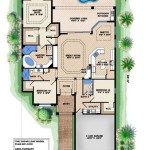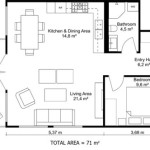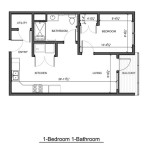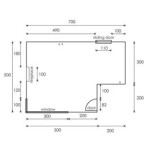How to Create an Effective Bedroom Floor Plan
A bedroom floor plan serves as the foundational blueprint for arranging furniture, optimizing space, and ensuring comfortable circulation within the sleeping quarters. A well-designed floor plan considers both the functional and aesthetic aspects of the room, leading to a more relaxing and enjoyable environment. Effective floor planning involves careful measurement, strategic furniture placement, and an understanding of basic design principles. This document outlines the necessary steps to create a bedroom floor plan that maximizes space and personal comfort.
1. Measuring and Documenting the Existing Space
The initial step in creating a bedroom floor plan involves accurately measuring the room's dimensions. This includes the length and width of each wall, as well as the height of the ceiling. Employ a measuring tape or a laser distance meter for precision. Ensure all measurements are recorded in a consistent unit, such as inches or centimeters, and convert them to feet or meters for drawing purposes. The accuracy of these measurements is paramount, as any errors will be replicated in the final floor plan. Document the location and size of architectural features, including windows, doors, closets, and any built-in elements like shelving or radiators. Note the swing direction of doors, as this significantly impacts furniture placement. Mark the positions of electrical outlets, light switches, and any existing plumbing fixtures. This comprehensive documentation ensures that the floor plan accurately reflects the room's existing conditions and constraints.
Create a rough sketch of the bedroom, including all measured dimensions and the locations of architectural features. This sketch serves as a visual reference during the planning process. Use graph paper or a digital drawing tool to maintain accurate proportions. A scale representation, such as 1/4 inch equals 1 foot, is recommended for clarity. Label each dimension and feature clearly on the sketch. This initial sketch is a working document and can be adjusted as the planning process progresses. Consider taking photographs of the room from multiple angles to provide additional visual references. These photographs can be helpful in visualizing the space and identifying potential design challenges. Finally, check the measurements for consistency and accuracy before proceeding to the next step.
2. Determining Functional Requirements and Prioritizing Needs
Before arranging furniture, define the primary functions of the bedroom. Beyond sleeping, consider activities such as dressing, reading, working, or exercising. Determine the essential furniture pieces required to support these activities. A bed is typically the focal point, but other common items include dressers, nightstands, desks, chairs, and storage units. Evaluate the size and quantity of each furniture piece. Prioritize based on available space and personal needs. A minimalist approach may be necessary in smaller bedrooms, while larger rooms can accommodate more elaborate layouts. Account for storage requirements. Consider the types of clothing and accessories to be stored, as well as any other items that need to be kept in the bedroom. Identify potential storage solutions, such as closets, drawers, shelves, or under-bed storage units.
Consider the desired aesthetic style. This influences the choice of furniture and accessories. A modern style may favor clean lines and minimalist furnishings, while a traditional style may incorporate more ornate details and classic pieces. Research different design styles and identify elements that appeal to personal preferences. Create a mood board or gather inspiration images to guide the design process. This visual reference will help in selecting furniture, colors, and textures that complement the overall aesthetic. Determine the desired level of natural light and ventilation. Consider the placement of windows and doors and how they affect the flow of light and air. Choose window treatments that provide privacy and control the amount of light entering the room. Ensure adequate ventilation to maintain a comfortable and healthy environment.
3. Experimenting with Furniture Placement and Circulation
Once the room dimensions and furniture requirements are established, begin experimenting with different furniture arrangements. Use the scaled sketch or a digital floor planning tool to visualize various layouts. Consider the focal point of the room, which is typically the bed. The bed should be positioned in a way that maximizes space and provides easy access to other areas of the room. Avoid placing the bed directly in front of a door or window if possible, as this can disrupt the flow of traffic and block natural light. Arrange the remaining furniture pieces around the bed, considering their size and function. Maintain adequate space between furniture items to allow for comfortable circulation. A minimum of two feet of clearance is generally recommended for walkways. Optimize the use of corners and walls to maximize storage and minimize clutter.
Pay attention to the placement of electrical outlets and light switches. Position furniture in a way that allows easy access to these utilities. Avoid placing furniture in front of outlets or switches, as this can be inconvenient and unsafe. Consider the placement of lighting fixtures. Incorporate a combination of ambient, task, and accent lighting to create a well-lit and inviting space. Ambient lighting provides general illumination, task lighting focuses on specific areas, such as a desk or reading chair, and accent lighting highlights architectural features or artwork. Evaluate the circulation paths within the room. Ensure that there is a clear and unobstructed path from the door to the bed and to other key areas, such as the closet or bathroom. Avoid creating bottlenecks or dead ends that can impede movement. Experiment with different layouts until a functional and aesthetically pleasing arrangement is achieved.
4. Utilizing Digital Floor Planning Tools
Digital floor planning tools offer a convenient and efficient way to create and visualize bedroom floor plans. These tools allow users to draw rooms to scale, add furniture, and experiment with different layouts. Many software programs and online applications are available, ranging from free and basic options to more advanced and feature-rich platforms. Some popular choices include SketchUp, Floorplanner, RoomSketcher, and Planner 5D. These tools typically offer a library of pre-designed furniture models that can be easily inserted into the floor plan. Users can also customize the dimensions and materials of these models to match their existing furniture or desired style. Digital floor planning tools often include features such as 3D visualization, which allows users to view the room from different perspectives and get a better sense of the space. These tools can also calculate the total area of the room and individual furniture pieces, providing valuable information for space planning.
Before using a digital floor planning tool, familiarize yourself with its interface and features. Most tools offer tutorials or help documentation to guide users through the basics. Start by drawing the room's outline to scale, using the measurements taken in the initial step. Add architectural features such as windows, doors, and closets, ensuring that their positions and dimensions are accurately represented. Insert furniture models into the floor plan, positioning them according to the desired layout. Experiment with different arrangements, using the tool's drag-and-drop functionality to easily move furniture pieces around. Use the 3D visualization feature to view the room from different angles and assess the overall design. Consider using the tool's measurement tools to verify clearances and ensure that there is adequate space for circulation. Save the floor plan and make any necessary revisions based on the visual assessment. Digital floor planning tools can save time and effort in the design process, allowing users to create professional-looking floor plans with ease.
5. Considering Ergonomics and Accessibility
Ergonomics plays a crucial role in creating a comfortable and functional bedroom. Ergonomics is the science of fitting workplace conditions and job demands to the capabilities of workers.. Ensure that furniture heights are appropriate for the user's height and reach. For example, the bed height should allow for easy getting in and out, and the desk height should promote good posture while working. Arrange furniture in a way that minimizes the need for bending, reaching, or twisting. Optimize the placement of lighting fixtures to reduce glare and eye strain. Consider the placement of electrical outlets and switches to minimize the need for extension cords, which can be a safety hazard. Ensure that there is adequate ventilation to maintain a comfortable temperature and prevent the buildup of moisture. Choose furniture with rounded edges and soft surfaces to prevent injuries. Consider the use of non-slip rugs or mats to reduce the risk of falls.
Accessibility is an important consideration for individuals with disabilities or mobility limitations. Ensure that there is adequate space for maneuvering wheelchairs or other mobility devices. Widen doorways and hallways to accommodate wheelchairs. Install grab bars in the bathroom and near the bed for added support. Lower light switches and electrical outlets to make them easily accessible. Choose furniture with adjustable heights to accommodate different users. Consider the use of ramps or lifts to overcome changes in elevation. Follow accessibility guidelines and standards to ensure that the bedroom is safe and functional for all users. The Americans with Disabilities Act (ADA) provides detailed guidelines for accessibility in residential and commercial spaces. Consulting with an occupational therapist or accessibility expert can provide valuable insights and recommendations.
6. Incorporating Personal Touches and Finishing Details
Once the functional layout is established, personalize the bedroom with finishing touches that reflect individual tastes and preferences. Choose a color palette that creates a relaxing and inviting atmosphere. Consider the use of soft and muted colors for walls and bedding, and add pops of color with accessories such as pillows, throws, and artwork. Incorporate personal items such as photographs, souvenirs, and collectibles to create a sense of identity and belonging. Add texture and pattern with rugs, curtains, and upholstery. Choose materials that are soft and comfortable to the touch, such as cotton, linen, or wool. Incorporate plants and greenery to add life and freshness to the room. Plants can also improve air quality and create a more calming environment. Choose artwork that inspires and uplifts. Consider the size and placement of artwork to create a balanced and harmonious composition. Add decorative lighting fixtures such as lamps, sconces, or chandeliers to create a warm and inviting ambiance.
Pay attention to the details. Choose high-quality hardware and fixtures that complement the overall design. Consider the use of scented candles or essential oil diffusers to create a relaxing and inviting atmosphere. Organize and declutter the space to create a sense of calm and order. Use storage solutions such as baskets, bins, and organizers to keep items neatly tucked away. Create a cozy and inviting reading nook with a comfortable chair, a soft blanket, and a good book. Personalize the bedroom with items that bring joy and comfort. Create a space that reflects individual style and personality.

How To Design A Bedroom Layout 8 Tips Consider

How To Design A Bedroom Layout 8 Tips Consider

Bedroom Designs

Master Bedroom Floor Plan Template

Floor Plans Learn How To Design And Plan

Bedroom Floor Plans Types Examples Considerations Cedreo

Bedroom With Toilet Floor Plan Template

Bedroom Designs

Bedroom Layout Plan

3 Box Bedroom Ideas The Best Small Room Layouts
Related Posts








